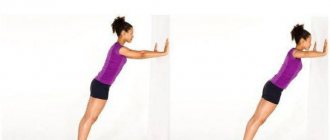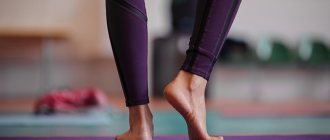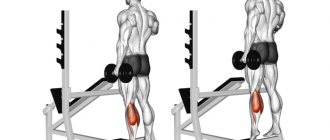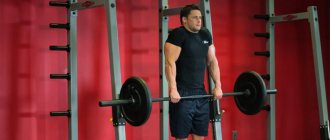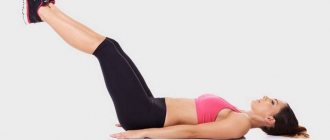Benefits of jumping rope
- Versatility of training. You can take the jump rope with you everywhere. It is convenient to train with it both at home and in the park or gym.
- Jumping rope improves cardiorespiratory function and also improves coordination, agility and speed.
- Jumping rope can be alternated with strength exercises, or used as a separate tool to maintain fitness.
- Training with a jump rope develops a variety of performance indicators and is suitable for most athletes, regardless of the sport.
- They help achieve excellent results in a short time - be it weight loss, muscle tone or speed endurance.
Ways to increase jump height
The task of increasing strength indicators faces many, both professional and amateur athletes. In team sports, success largely depends on the strength and height of the jump. Therefore, a volleyball player, basketball player and even a gymnast sooner or later thinks about how to learn to jump high.
In sports practice there is a term “explosive strength”. It refers to the ability of a muscle to push your body weight to a certain height. In boxing they develop explosive strength in the arms, in breakdancing and gymnastics - in the arms and legs, in basketball - mainly in the legs. If your goal is to develop jumping ability, you should pay attention to developing explosive power.
Types of jump ropes
Rope jump ropes
This is the most common type. They usually have plastic handles and fabric or nylon rope. They are cheap and the quality is often quite poor. Such jump ropes have two disadvantages - they are heavy and slow. This is not the best choice for crossfit, boxing, or aerobics athletes. Also, you should not use the jump rope on wet ground, as the fabric rope will absorb moisture, becoming even heavier.
Jump ropes with plastic beads
These are the best jump ropes for beginners as the sound on the floor helps you find your rhythm. The only downside is that the plastic beads may break over time. In addition, once you master simple jumps and gain some experience, your body will require increased speed, which cannot be achieved with this type of jump rope.
Leather jump rope
The popular leather boxing rope was a favorite of legends such as Muhammad Ali, Mike Tyson or George Foreman. They used them to improve coordination and leg speed, which helps gain confidence in the ring where agility is key. These boxing ropes have plastic or wooden handles and are faster than plastic or fabric ones. However, it is an organic material, so you need to be careful when using the jump rope outdoors and in areas exposed to moisture.
Plastic or PVC jump rope
These are the most popular jump ropes in the market and their price varies depending on their quality. These ropes are suitable for beginners and more experienced athletes, but are not recommended for training where speed is important . For example, when performing milking jumps on a jump rope in Crossfit, it will be more difficult to cope with this type, since the weight and thickness of the rope are unbalanced. However, for simple jumps and other types of training it is more than enough. One of the advantages of these jump ropes is that they can be used outdoors without any problems. They last a long time, even on hard surfaces.
Jump ropes with steel cable
This type of jump rope has gained popularity among CrossFit athletes who need to double jump as quickly as possible. These jump ropes are mainly designed for one purpose - increasing speed .
There are 2 types of cable: 4 mm and 2.5 mm.
- 2.5 mm cables are designed for high-speed jumping. Not recommended for beginners because it is more difficult to choose the technique with them. However, they cause less muscle fatigue, making them ideal for competition.
- Training with a 4mm cable allows athletes to have a better feel for the rope. The service life is longer compared to 2.5 mm cables, since the PVC or plastic coating is thicker. Keep in mind that these jump ropes are made of very dense cable. This means that they are very fast, but painful. Avoid use on concrete , as the hard surface may wear away the plastic.
Jump ropes with weights
These jump ropes are designed to increase wrist and forearm strength .
Used for strength training or as the only equipment when performing cardio and endurance training. Not suitable for developing speed. The handle of the jump ropes is provided with the installation of weights, 100 grams on each side. These handles are ergonomic and allow you to train longer without hand fatigue. Weighted handles and thicker cables are great for increasing power and endurance at the same time. These jump ropes are not suitable for beginners and require some training experience.
Jump ropes with electronic counter
This type of jump rope is very convenient, because the high-speed rotation system makes movements faster, and there is no need to count jumps . This is especially convenient when training for a certain number of jumps in the shortest possible time, when there is a possibility of losing count.
AIR ALERT III
The program was developed by TMT sports based on the very popular program, Air Alert II. The program has undergone many changes. Due to the new exercise and the increase in the course (15 weeks), the creators reduced the frequency of the exercises to 3 days a week (except for the last, 15th week), but now it will have to be performed on certain days of certain weeks! After completing the full course (15 weeks), you will increase your jump by 20–35 cm. During the 4 months of completion, you should ensure yourself good sleep and nutrition.
High jump
Execution: Feet shoulder width apart. Jump straight up as far as you can. Once down, squat down to about a quarter—that’s one jump.
Note: The speed of the jump is most important when performing the exercise. The point is to jump out as quickly as possible. The time spent on the ground should be equal to fractions of a second.
Calf raises
Execution: Stand on something so that your heels do not touch the floor (stairs, thick book). Rise up on one leg as high as possible, then on the other leg.
Rest between sets: 25–30 seconds.
Step-ups
Execution: Place one foot on a strong platform (chair, bench) and push up with your supporting leg. In the air, change your supporting leg and repeat the same.
How to choose the right jump rope
By purpose and place of use
- The most important thing when choosing a jump rope is the thickness, density of the cable and the material from which it is made.
- High and medium density ropes such as PVC or 4mm steel ropes are most suitable for beginners.
- If you want to train according to the CrossFit or functional training system, you should choose steel cables: 2.5 mm for those who are trained, and 4 mm for beginners.
- For martial arts, 4mm steel or leather ropes are best.
- If you plan to jump rope for the entire workout, you can choose a jump rope with weights in the handles.
- The handles should be comfortable to grip. For CrossFit, look for comfortable, lightweight handles, preferably made from durable materials such as metal.
- If you are training outdoors, you can use either weighted jump ropes (PVC coated cable) or steel ropes, preferably 4mm.
- For outdoor activities in wet conditions, leather or rope jump ropes with wooden handles are not recommended.
- You can use any jump rope indoors depending on your goals. Ideally, train on rubber floors over a concrete base.
- The most important thing is that the jump rope must be correctly adjusted for height.
How to choose the ideal length of a jump rope based on your height
The correct length is checked by standing with one foot on the rope, raising both hands with handles to chest level. If the handles reach chest level, this will be an ideal option at the initial stage.
How to jump rope correctly
Basic jump technique.
- Keep your feet close to each other as you jump.
- Always land softly on the middle of your feet.
- Keep your jump height low (up to 3 cm from the ground).
- Always keep your knees slightly bent.
- Keep your spine straight.
- Keep your head straight.
- Keep your shoulders slightly extended back and your elbows tucked toward your torso.
- Keep your hands level with the midline of your body.
- Gently rotate your wrists to rotate the rope, not your elbows or shoulders.
What muscles are used when jumping
The main criterion for jump height is the force of the jerk that the body is capable of. To figure out how to increase your jump height in basketball, you need to understand which muscles work during this technical element.
Of course, the main load falls on the legs, more precisely, on the calves and quadriceps. The front of the thigh is the largest muscle group in humans. She is responsible for how the body will be pushed out of place. However, is no less important when jumping .
How to increase your results
First of all, the athlete is obliged to develop and train those muscles and ligaments that provide propulsion when jumping. This process occurs like a “domino effect” - from the ankle to the shin and thigh . In addition to the above groups, do not forget about the stabilizer muscles. These are the muscles of the back and abdomen. In many recommendations for jump training you can find exercises specifically for these muscle groups.
Attention! Many beginners make the same mistake, thinking that exercises can be done on a free schedule. Remember that only regular training will give the desired effect.
Jumping rope program for weight loss
Perform training every other day, performing the specified number of jumps. If necessary, you can pause between jumps.
| Day | Number of jumps |
| 1 | 100 |
| 2 | 130-150 |
| 3 | 150-180 |
| 4 | 180-210 |
| 5 | 210-240 |
| 6 | 240-270 |
| 7 | 270-300 |
| 8 | 300-330 |
| 9 | 330-360 |
| 10 | 360-390 |
| 11 | 390-420 |
| 12 | 420-450 |
| 13 | 450-480 |
| 14 | 480-510 |
| 15 | 510-550 |
More programs with a jump rope for weight loss →
Jumping on straight legs
Execution: Feet shoulder width apart. Make high jumps without bending your knees. You need to jump as high as possible.
Rest between sets: 1 minute.
Note: The speed of the jump is most important when performing the exercise. The point is to jump out as quickly as possible. The time spent on the ground should be equal to fractions of a second.
Burnout
Execution: The exercise is named so because when performed correctly, you will feel a burning sensation in the leg muscles. Standing in a half-squat, rise on your toes and jump in this position without falling on your heels. When performing, place the main emphasis on speed and be careful not to sink onto your heels.
Jumping in a full squat.
Full squat jumps are a new exercise. It should load the entire thigh and help increase its 'explosive strength'. It increases cardiovascular endurance, short-distance speed and lateral speed.
So, the description of the exercise:
- For balance, hold the ball in your hands (optional).
- Sit down. You should be sitting on your toes (heels raised), with your thighs parallel to the floor and your back perpendicular to the floor.
- Jump 10–15 cm. Keep the floor and hips parallel.
- After landing, push off again.
- For the last time (example: fifteenth of 15 jumps), jump as high as possible (from a sitting position up).
This exercise puts a very heavy load on the muscles and therefore needs to be performed only once a week, on Wednesdays. Increasing the frequency of the exercise will lead to the risk of overloading the muscles, increasing recovery time and reducing the jumping tone of the legs for a long time. At the end of each set, you should jump up at a maximum, explosive pace and to the highest possible height. It is very important to jump out as quickly as possible. This will force the thigh muscles to work, strengthen them and add another 3-5 cm to the jump over the entire course.
Schedule:
| A week | High jump | Calf raises | Step-ups | Jumping on toes | Burnout | Jumping in full squat |
| 1 | 2×20 | 2×10 | 2×10 | 2×15 | 1×100 | 4×15 |
| 2 | 3×20 | 2×15 | 2×15 | 2×20 | 1×200 | 4×20 |
| 3 | 3×25 | 2×20 | 2×15 | 2×25 | 1×300 | 4×20 |
| 4 | 3×30 | 2×25 | 2×20 | 2×30 | 2×200 | 4×20 |
| 5 | 4×25 | 2×30 | 2×20 | 2×35 | 2×250 | 4×25 |
| 6 | 2×50 | 2×35 | 2×25 | 2×40 | 2×300 | 4×30 |
| 7 | 4×30 | 2×40 | 2×25 | 2×50 | 2×350 | 5×25 |
| 8 | 3×50 | 2×45 | 2×30 | 2×60 | 4×200 | 5×25 |
| 9 | 4×50 | 2×50 | 2×30 | 2×70 | 3×300 | 5×30 |
| 10 | 5×40 | 2×55 | 2×35 | 2×80 | 4×250 | 5×30 |
| 11 | 6×50 | 4×30 | 2×35 | 2×90 | 4×275 | 5×30 |
| 12 | 4×75 | 4×35 | 2×40 | 2×100 | 4×300 | 6×30 |
| 13 | The program is not running! | |||||
| 14* | 3×30 | 2×30 | 2×20 | 2×30 | 1×250 | 4×20 |
| 15** | 4×100 | 4×50 | 2×50 | 2×100 | 4×400 | 5×50 |
Air Alert III must be performed 3 days a week and preferably at the same time. The program takes 15 weeks in total.
2x25 means doing two sets of 25 reps.
In the third version of the program, rest between approaches should not exceed 2 minutes, and there SHOULD NOT be a break between exercises! During the pause between approaches, massage the muscle groups that received the load.
It is best to perform the program at 13-15 hours of the day (peak muscle work).
The 13th week requires complete rest. The program execution must be stopped!
14* - this week is done to prepare for the last week. Therefore, the number of executions is reduced.
15** - Week 15 exercises are performed on Monday, Tuesday, Thursday and Friday. The last week puts maximum stress on the muscles before final recovery. Therefore, the number of repetitions has been increased and classes are held for 4 days. Jumping ability will reach its maximum level 4-7 days after the end of the program.
Important! Air ALERT III has its own specific execution schedule!
On even weeks (2,4...) the program runs on Tuesdays, Wednesdays and Thursdays.
On odd-numbered weeks, perform the program on Mondays, Wednesdays and Fridays.
On days when you don't need to do AA3, you should still give your legs the usual jumping load. This is best done during games. Come out and play! But try to do all the jumps as aggressively as possible. This will strengthen muscle memory.
If you wish, you can take the program again, but:
- the break between executions must be at least a month;
- doing it again will not give as good results as the first time.
Top 3 jump rope manufacturers
- Torneo. The brand represents every possible variety of jump ropes. One invention of the brand that can be highlighted is a jump rope with an electric counter. The approximate price of such a product is 600 rubles. The starting price for other jump ropes from the manufacturer is only 99 rubles.
- Green Hill. The manufacturer produces high-quality Leather jump ropes with wooden handles. Another feature is the presence of special weights in the handles. The approximate cost of the jump rope is 800 rubles.
- MONKO. The brand produces steel cable jump ropes called SPEED ROPE specifically for CrossFit. The jump rope helps you reach speeds of up to two hundred revolutions per minute. Approximate cost: 550 rubles.
